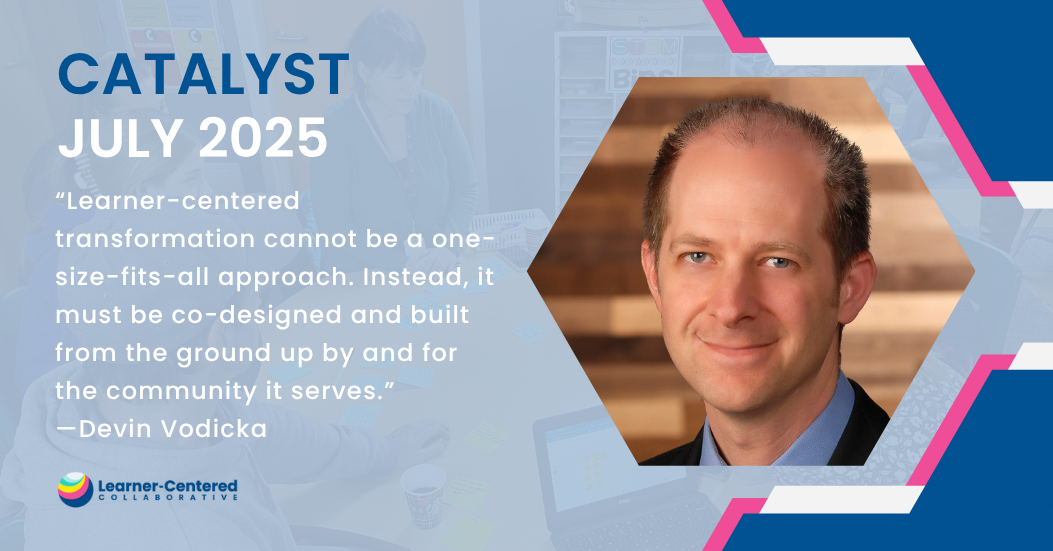The Role of Reading in Learner-Centered Education
This article, featuring Learner-Centered Collaborative CEO Devin Vodicka, was written and originally published by Zoobean.

When Devin Vodicka, then superintendent of Vista Unified School District, asked students to describe their academic experience, one word came up again and again: “irrelevant.” Across the board, students felt like school wasn’t preparing them for the real world—and that they didn’t have any power to change it. As one student said, “I don’t want school to happen to me. I want to drive my own learning.”
These conversations with students started Vodicka on the long journey toward what would become Learner-Centered Collaborative, a non-profit organization that partners with schools to implement learner-centered education (LCE). In this blog, we’re taking a closer look at the LCE framework—and exploring the pivotal role that reading plays in learner-centered education.
Understanding Learner-Centered Education
When Vodicka’s students told him their learning was irrelevant, he knew he had to take a more holistic approach. In response, he and co-founder Katie Martin began to define learner-centered education. First, they would talk with learners themselves about what fascinates and excites them—and then set out to create learning experiences and school cultures that support those interests.
LCE is personalized, interdisciplinary, and grounded in the real world. For example, one school in Vermont offers technical courses on the science of maple sugaring, a booming local industry. Meanwhile, at another school in Manhattan, students are studying mass transit systems. These wildly different learning experiences have real-world context in the communities where these students live.
Although no two learner-centered programs are alike, some skills play a foundational role in making the LCE philosophy work in any environment. These skills are woven into the fabric of every learning opportunity—whether the focus is ending world hunger or uncovering local history. One of those critical skills, according to Vodicka, is reading.

4 Ways That Reading Supports Learner-Centered Education
Literacy is at the heart of LCE—but how exactly does it contribute to student success? Here’s how reading supports four critical components of the learner-centered education framework:
Agency
Agency is about self-motivated learning—and students’ strengths and interests often drive that. But the current educational system often doesn’t teach students how to find their passions.
Vodicka recalls one teacher who created a “genius hour” in which her second graders could do any activity that tapped into their unique genius. But on the first day, her students had no idea what interested them—or even what they were good at. For students who don’t know what they care about yet, reading offers the opportunity to discover the people, places, and ideas that fascinate them. It goes beyond the standardized curriculum and gives them the time and space to find what they truly care about. On top of that, reading allows students to set and achieve micro goals—like finishing the next chapter before the end of class or reading 20 books by the end of the school year. These goal-setting skills are critical for self-motivated learning.
Download the free eBook Fostering Learner Agency From the District Office to the Classroom.
Collaboration
Learner-centered education isn’t just about encouraging students to succeed on their own—it’s about teaching them how to collaborate and grow as a part of a community. While many people think of reading as an independent activity, it also can be a collaborative and social experience; for instance, students can take part in book circles where they ask questions and help each other understand the book on a deeper level. Books can also give students shared language and knowledge to understand complex topics. For example, reading the same story about a character with mental illness can help students have a more productive and thoughtful discussion about mental health in their own communities.

Real-World Problem Solving
When educators think about real-world problem solving, they often think about students diving in and getting their hands dirty—not sitting down to read. But reading is at the root of problem-solving. If students are trying to figure out how to reduce pollution in their community, they might not know where to begin. But once they research the primary polluters in the area, learn about how to minimize current environmental damage, and discover what local initiatives are already underway, they’ll have the knowledge they need to sink their teeth in.
Reading can also benefit real-world problem solving by helping students understand why these issues matter. Statistics can be powerful, but they rarely tap into our humanity. Stories can help students understand the human impact of the problem they are trying to solve—and how their work will make a difference.
Devin Vodicka shares strategies and examples for Leading the Way to Authentic Learning in this blog post.
Equity and Inclusion
Even the most motivated students will struggle in a school culture that isn’t equitable and inclusive. Fortunately, reading can help build a more inclusive community by encouraging students to expand their horizons and see things from another person’s point of view. For students in isolated, rural communities, books offer insight into people of other races, nationalities, genders, and more. Even for students in more diverse urban centers, books can be a window into what life is like for rural farmers, or people across the globe. Plus, research has shown that reading improves empathy—especially if students read literary fiction that focuses on the psychology of the characters. When students read, they not only recognize other perspectives—they are also more likely to empathize with them.

Expanding Student Horizons
Today, more than 1 million students in 130 school districts are driving their own learning with help from the Learner-Centered Collaborative. They are solving real problems and following their passions—not just consuming premade content. And this, Martin and Vodicka argue, is how it should be. As Martin writes: “To ensure that our children are actually learning, we need to find authentic ways to expose them to the world, expand their horizons, and spark their interest in areas that we want them to genuinely care about.” And really, what better way is there to expand students’ horizons than to encourage them to crack open a book, and discover a world entirely unlike their own?
Learn more about Beanstack for Schools






